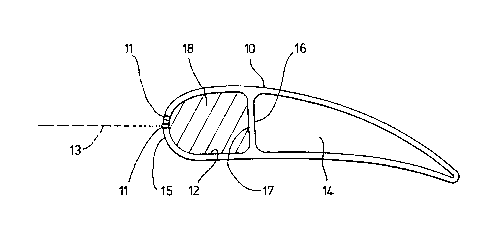Une partie des informations de ce site Web a été fournie par des sources externes. Le gouvernement du Canada n'assume aucune responsabilité concernant la précision, l'actualité ou la fiabilité des informations fournies par les sources externes. Les utilisateurs qui désirent employer cette information devraient consulter directement la source des informations. Le contenu fourni par les sources externes n'est pas assujetti aux exigences sur les langues officielles, la protection des renseignements personnels et l'accessibilité.
L'apparition de différences dans le texte et l'image des Revendications et de l'Abrégé dépend du moment auquel le document est publié. Les textes des Revendications et de l'Abrégé sont affichés :
| (12) Brevet: | (11) CA 2041356 |
|---|---|
| (54) Titre français: | PERCAGE AU LASER |
| (54) Titre anglais: | LASER DRILLING |
| Statut: | Périmé et au-delà du délai pour l’annulation |
| (51) Classification internationale des brevets (CIB): |
|
|---|---|
| (72) Inventeurs : |
|
| (73) Titulaires : |
|
| (71) Demandeurs : |
|
| (74) Agent: | GOWLING WLG (CANADA) LLP |
| (74) Co-agent: | |
| (45) Délivré: | 1997-11-25 |
| (22) Date de dépôt: | 1991-04-26 |
| (41) Mise à la disponibilité du public: | 1991-10-27 |
| Requête d'examen: | 1994-05-26 |
| Licence disponible: | S.O. |
| Cédé au domaine public: | S.O. |
| (25) Langue des documents déposés: | Anglais |
| Traité de coopération en matière de brevets (PCT): | Non |
|---|
| (30) Données de priorité de la demande: | ||||||
|---|---|---|---|---|---|---|
|
L'invention est un matériau servant à empêcher l'endommagement de la paroi arrière d'une cavité à l'intérieur d'un composant durant le perçage de trous dans ce composant au moyen d'un laser. Ce matériau contient une résine acrylique dans laquelle un polytétrafluoroéthylène est en dispersion, et qui est polymérisée avant le perçage au laser. Une méthode utilisant ce matériau pour empêcher l'endommagement de la paroi arrière durant les opérations de perçage au laser est également divulguée. Dans cette méthode, la cavité qui est à l'intérieur du composant est au moins partiellement remplie avec un matériau contenant un monomère de résine acrylique et un polytétrafluoroéthylène, ce monomère contenant un agent d'amorçage approprié pour faciliter la polymérisation; le perçage au laser se fait pour permettre la polymérisation de ce matériau in situ dans la cavité.
A material is described for preventing the
occurrence of damage to the backwall of a cavity within
a component during laser drilling of holes into said
component. The material comprises an acrylic resin
having polytetrafluoroethylene dispersed within it and
is polymerized before laser drilling. A method for
preventing such backwall damage occurring during laser
drilling using this material is also described and the
method comprises the steps of at least partially
filling the cavity in the component with a material
comprising an acrylic resin monomer and
polytetrafluoroethylene (PTFE), the monomer
incorporating a suitable initiator to promote
polymerisation, and allowing said material to
polymerise in situ in the cavity prior to laser
drilling.
Note : Les revendications sont présentées dans la langue officielle dans laquelle elles ont été soumises.
Note : Les descriptions sont présentées dans la langue officielle dans laquelle elles ont été soumises.

2024-08-01 : Dans le cadre de la transition vers les Brevets de nouvelle génération (BNG), la base de données sur les brevets canadiens (BDBC) contient désormais un Historique d'événement plus détaillé, qui reproduit le Journal des événements de notre nouvelle solution interne.
Veuillez noter que les événements débutant par « Inactive : » se réfèrent à des événements qui ne sont plus utilisés dans notre nouvelle solution interne.
Pour une meilleure compréhension de l'état de la demande ou brevet qui figure sur cette page, la rubrique Mise en garde , et les descriptions de Brevet , Historique d'événement , Taxes périodiques et Historique des paiements devraient être consultées.
| Description | Date |
|---|---|
| Le délai pour l'annulation est expiré | 2001-04-26 |
| Lettre envoyée | 2000-04-26 |
| Accordé par délivrance | 1997-11-25 |
| Inactive : Dem. traitée sur TS dès date d'ent. journal | 1997-09-22 |
| Inactive : Renseign. sur l'état - Complets dès date d'ent. journ. | 1997-09-22 |
| Préoctroi | 1997-06-03 |
| Inactive : Demande ad hoc documentée | 1997-04-28 |
| Réputée abandonnée - omission de répondre à un avis sur les taxes pour le maintien en état | 1997-04-28 |
| Un avis d'acceptation est envoyé | 1996-12-10 |
| Exigences pour une requête d'examen - jugée conforme | 1994-05-26 |
| Toutes les exigences pour l'examen - jugée conforme | 1994-05-26 |
| Demande publiée (accessible au public) | 1991-10-27 |
| Date d'abandonnement | Raison | Date de rétablissement |
|---|---|---|
| 1997-04-28 |
| Type de taxes | Anniversaire | Échéance | Date payée |
|---|---|---|---|
| Enregistrement d'un document | 1997-05-21 | ||
| Taxe finale - générale | 1997-06-03 | ||
| TM (brevet, 7e anniv.) - générale | 1998-04-27 | 1998-03-16 | |
| TM (brevet, 8e anniv.) - générale | 1999-04-26 | 1999-03-17 |
Les titulaires actuels et antérieures au dossier sont affichés en ordre alphabétique.
| Titulaires actuels au dossier |
|---|
| AETC LIMITED |
| Titulaires antérieures au dossier |
|---|
| GLYNDWYR J. DAVIES |
| JONATHON D. PHILBY |